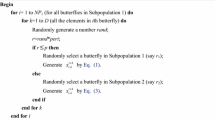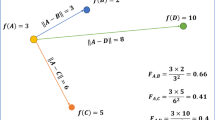Abstract
Due to the multimodal nature of real-world optimization problems, in recent years, there has been a great interest in multi-modal optimization algorithms. Multimodal optimization problems involve identifying multiple local/global optima. Niching techniques have been widely used to tackle multi-modal optimization problems. Most of the existing niching methods either require predefined niching parameters or extra information about the problem space. This paper presents a novel multimodal algorithm based on Butterfly Optimization Algorithm, which is constructed using the Fitness-Distance Balance (FDB) selection method. The purpose of applying the FDB selection method is to discover local/global optima with high potential as a fitness value along with the appropriate distance from solution candidates. Also, a local search scheme is used to enhance the convergence speed of the algorithm. Niching is a technique used in multimodal optimization to maintain diversity among multiple solutions in the population. The minimum distance between the solutions is called a “niche”. The proper niching radius is the main challenge for existing approaches. Knowing the problem space helps determine the niche radius. This paper proposes a new multimodal optimization scheme that does not require prior knowledge of the problem space or the niching parameter. Seven state-of-the-art multi-modal optimization algorithms are compared to the multi-modal butterfly optimization algorithm (MBOA) on 16 benchmarks from the CEC 2013 and CEC 2015 competitions to evaluate its performance. Success rate, Number of function evaluations, Success performance, average number of optima found, Success accuracy, Maximum peak ratio, and Run-time performance criteria were measured over 25 runs to assess the efficiency of the proposed method. The experimental results demonstrate that MBOA outperforms other algorithms according to most of the performance criteria.





Similar content being viewed by others
Data availability
Enquiries about data availability should be directed to the authors.
References
Akan T, Agahian S, Dehkharghani R (2022) Binbro: binary battle royale optimizer algorithm. Expert Syst Appl 195:116599
Arora S, Singh S (2019) Butterfly optimization algorithm: a novel approach for global optimization. Soft Comput 23(3):715–734
Barrera J, Coello CAC (2009) A particle swarm optimization method for multimodal optimization based on electrostatic interaction. Mexican international conference on artificial intelligence. Springer, pp 622–632
Beasley D, Bull DR, Martin RR (1993) A sequential niche technique for multimodal function optimization. Evol Comput 1(2):101–125
Cetin A, Rezai S, Akan T (2023) Multi-circle detection using multimodal optimization. In: Akan T, Anter AM, Şima Etaner-Uyar A, Oliva D (eds) Engineering applications of modern metaheuristics. Springer, Cham, pp 193–209
Epitropakis MG, Tasoulis DK, Pavlidis NG, Plagianakos VP, Vrahatis MN (2011) Enhancing differential evolution utilizing proximity-based mutation operators. IEEE Trans Evol Comput 15(1):99–119
Farshi TR (2021) A memetic animal migration optimizer for multimodal optimization. Evol Syst. https://doi.org/10.1007/s12530-021-09368-3
Farshi TR (2022) A memetic animal migration optimizer for multimodal optimization. Evol Syst 13(1):133–144
Farshi TR, Orujpour M (2021) A multi-modal bacterial foraging optimization algorithm. J Amb Intell Hum Comput. https://doi.org/10.1007/s12652-020-02755-9
Farshi TR, Drake JH, Özcan E (2020) A multimodal particle swarm optimization-based approach for image segmentation. Expert Syst Appl 149:113233
Farshi TR (2021) Battle royale optimization algorithm
Gálvez J, Cuevas E, Avalos O (2017) Flower pollination algorithm for multimodal optimization. Int J Comput Intell Syst 10(1):627–646
Goldberg DE, Richardson J (1987) Genetic algorithms with sharing for multimodal function optimization. In Genetic algorithms and their applications: Proceedings of the Second International Conference on Genetic Algorithms. Lawrence Erlbaum, Hillsdale. pp. 41–49
Gong S-P, Khishe M, Mohammadi M (2022) Niching chimp optimization for constraint multimodal engineering optimization problems. Expert Syst Appl 198:116887
Harik GR (1995) Finding multimodal solutions using restricted tournament selection. In: ICGA.pp. 24–31
Hastings CA, Norton SM, Roy S (2002) New algorithms for processing and peak detection in liquid chromatography/mass spectrometry data. Rapid Commun Mass Spectrom 16(5):462–467
Horowitz SL (1975) A syntactic algorithm for peak detection in waveforms with applications to cardiography. Commun ACM 18(5):281–285
Jacobson A (2001) Auto-threshold peak detection in physiological signals. In: 2001 Conference proceedings of the 23rd annual international conference of the IEEE engineering in medicine and biology society. vol. 3: IEEE, pp. 2194–2195
Kahraman HT, Aras S, Gedikli E (2020) Fitness-distance balance (FDB): a new selection method for meta-heuristic search algorithms. Knowl-Based Syst 190:105169
Khishe M, Orouji N, Mosavi M (2023) Multi-objective chimp optimizer: an innovative algorithm for multi-objective problems. Expert Syst Appl 211:118734
Li JP, Wood AS (2009) An adaptive species conservation genetic algorithm for multimodal optimization. Int J Numer Meth Eng 79(13):1633–1661
Li J-P, Balazs ME, Parks GT, Clarkson PJ (2002) A species conserving genetic algorithm for multimodal function optimization. Evol Comput 10(3):207–234
Li M, Lin D, Kou J (2012) A hybrid niching PSO enhanced with recombination-replacement crowding strategy for multimodal function optimization. Appl Soft Comput 12(3):975–987
Li X, Zhang J, Yin M (2014) Animal migration optimization: an optimization algorithm inspired by animal migration behavior. Neural Comput Appl 24:1867–1877
Li X (2007) A multimodal particle swarm optimizer based on fitness Euclidean-distance ratio. In: Proceedings of the 9th annual conference on Genetic and evolutionary computation. pp. 78–85
Li X, Engelbrecht A, Epitropakis MG (2013) Benchmark functions for CEC’2013 special session and competition on niching methods for multimodal function optimization. In: RMIT University, evolutionary computation and machine learning Group, Australia, Tech. Rep
Mahfoud SW (1992) Crowding and preselection revisited. PPSN 2:27–36
Miller BL, Shaw MJ (1996) Genetic algorithms with dynamic niche sharing for multimodal function optimization. In: Proceedings of IEEE international conference on evolutionary computation. IEEE, pp. 786–791
Orujpour M, Feizi-Derakhshi M-R, Rahkar-Farshi T (2019) Multi-modal forest optimization algorithm. Neural Comput Appl. https://doi.org/10.1007/s00521-019-04113-z
Passino KM (2012) Bacterial foraging optimization. In: Shi Y (ed) Innovations and developments of swarm intelligence applications. IGI Global, pp 219–234
Peters S, Vivó-Truyols G, Marriott PJ, Schoenmakers PJ (2007) Development of an algorithm for peak detection in comprehensive two-dimensional chromatography. J Chromatogr A 1156(1–2):14–24
Pétrowski A (1996) A clearing procedure as a niching method for genetic algorithms. In: Proceedings of IEEE international conference on evolutionary computation. IEEE, pp. 798–803
Qu B-Y, Suganthan PN, Liang J-J (2012a) Differential evolution with neighborhood mutation for multimodal optimization. IEEE Trans Evol Comput 16(5):601–614
Qu B-Y, Liang JJ, Suganthan PN (2012b) Niching particle swarm optimization with local search for multi-modal optimization. Inf Sci 197:131–143
Qu B-Y, Liang JJ, Wang Z, Chen Q, Suganthan PN (2016) Novel benchmark functions for continuous multimodal optimization with comparative results. Swarm Evol Comput 26:23–34
Rahkar Farshi T, Demirci R (2021) Multilevel image thresholding with multimodal optimization. Multimedia Tools Appl 80(10):15273–15289
Rahkar Farshi T, Orujpour M (2021) A multi-modal bacterial foraging optimization algorithm. J Amb Intell Hum Comput. https://doi.org/10.1007/s12652-020-02755-9
Rahkar-Farshi T, Behjat-Jamal S (2016) A multimodal firefly optimization algorithm based on Coulomb’s Law. Int J Adv Comput Sci Appl 7(5):134–141
Rahkar-Farshi T, Kesemen O, Behjat-Jamal S (2014) Multi hyperbole detection on images using modified artificial bee colony (ABC) for multimodal function optimization. In: 2014 22nd signal processing and communications applications conference (SIU), 2014: IEEE, pp. 894–898
Sacco WF, Henderson N, Rios-Coelho AC (2014) Topographical clearing differential evolution: a new method to solve multimodal optimization problems. Prog Nucl Energy 71:269–278
Sareni B, Krahenbuhl L (1998) Fitness sharing and niching methods revisited. IEEE Trans Evol Comput 2(3):97–106
Sharifi-Noghabi H, Mashhadi HR, Shojaee K (2017) A novel mutation operator based on the union of fitness and design spaces information for differential evolution. Soft Comput 21(22):6555–6562
Streichert F, Stein G, Ulmer H, Zell A (2003) A clustering based niching ea for multimodal search spaces. International conference on artificial evolution (Evolution Artificielle). Springer, pp 293–304
Tan DZ, Chen WN, Zhang J, Yu WJ (2017) Fast pedestrian detection using multimodal estimation of distribution algorithms. In: Proceedings of the genetic and evolutionary computation conference. pp. 1248–1255
Thirugnanasambandam K, Prakash S, Subramanian V, Pothula S, Thirumal V (2019) Reinforced cuckoo search algorithm-based multimodal optimization. Appl Intell 49(6):2059–2083
Wang Z-J, Zhan Z-H, Zhang J (2019) Distributed minimum spanning tree differential evolution for multimodal optimization problems. Soft Comput 23(24):13339–13349
Wang B, Liu L, Li Y, Khishe M (2022) Robust Grey Wolf optimizer for multimodal optimizations: a cross-dimensional coordination approach. J Sci Comput 92(3):110
Wang ZJ, Zhan ZH, Zhang J (2015) An improved method for comprehensive learning particle swarm optimization. In: 2015 IEEE Symposium series on computational intelligence. IEEE, pp. 218–225
Weber M, Tirronen V, Neri F (2010) Scale factor inheritance mechanism in distributed differential evolution. Soft Comput 14(11):1187–1207
Wolpert DH, Macready WG (1997) No free lunch theorems for optimization. IEEE Trans Evol Comput 1(1):67–82
Wong KC, Leung KS, Wong MH (2010) Protein structure prediction on a lattice model via multimodal optimization techniques. In: Proceedings of the 12th annual conference on Genetic and evolutionary computation. pp. 155–162
Woo D-K, Choi J-H, Ali M, Jung H-K (2011) A novel multimodal optimization algorithm applied to electromagnetic optimization. IEEE Trans Magn 47(6):1667–1673
Yazdani S, Nezamabadi-pour H, Kamyab S (2014) A gravitational search algorithm for multimodal optimization. Swarm Evol Comput 14:1–14
Yin X, Germay N (1993) A fast genetic algorithm with sharing scheme using cluster analysis methods in multimodal function optimization. Artificial neural nets and genetic algorithms. Springer, pp 450–457
Funding
The authors have not disclosed any funding.
Author information
Authors and Affiliations
Corresponding author
Ethics declarations
Conflict of interest
The authors declare no conflict of interest in this study.
Additional information
Publisher's Note
Springer Nature remains neutral with regard to jurisdictional claims in published maps and institutional affiliations.
Rights and permissions
Springer Nature or its licensor (e.g. a society or other partner) holds exclusive rights to this article under a publishing agreement with the author(s) or other rightsholder(s); author self-archiving of the accepted manuscript version of this article is solely governed by the terms of such publishing agreement and applicable law.
About this article
Cite this article
Orujpour, M., Feizi-Derakhshi, MR. & Akan, T. A multimodal butterfly optimization using fitness-distance balance. Soft Comput 27, 17909–17922 (2023). https://doi.org/10.1007/s00500-023-09074-z
Accepted:
Published:
Issue Date:
DOI: https://doi.org/10.1007/s00500-023-09074-z




